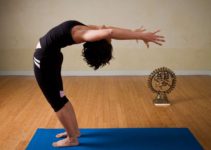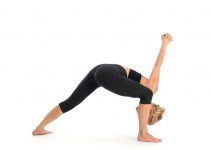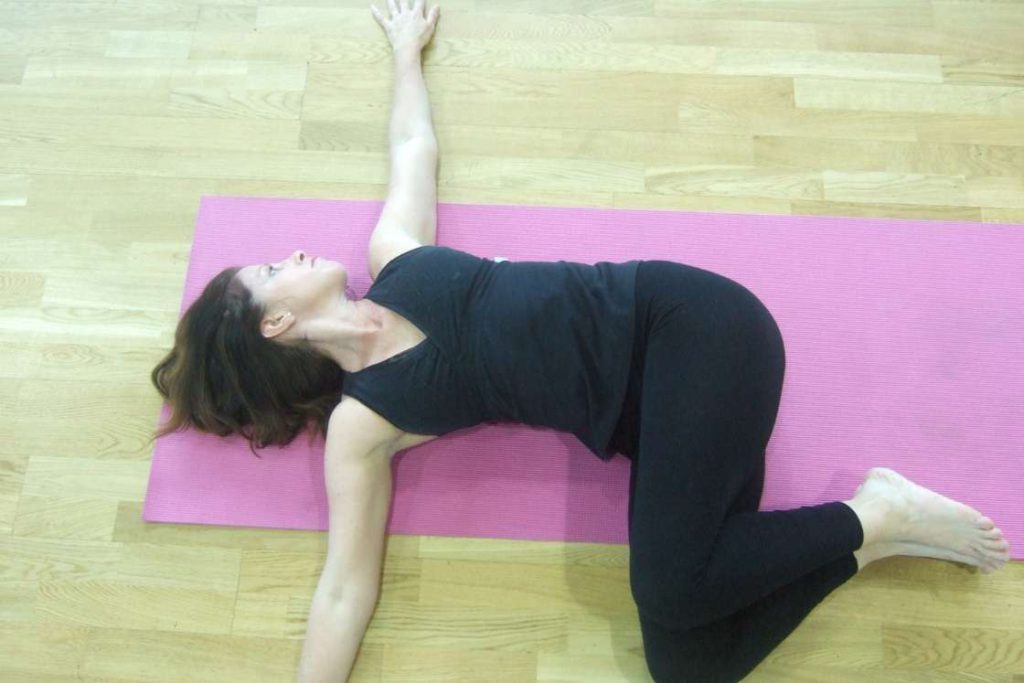
“Jathara” refers to “abdomen” or “belly”, “Parivartan” means “revolved or twisted”, and “asana” means “posture”. Jathara Parivartanasana is a supine pose in which the abdomen undergoes twisting while lying down in a supine position. This twist is achieved by resting the bent legs to one side on the floor and turning the neck and spine to the other.
The resultant wringing action achieved in the abdomen makes jathara parivartanasana. Besides toning the back and abdomen, it uplifts serotonin levels, i.e. the feel-good chemical into the body.
You can add this pose to your relaxing routine either after an intense workout or at the end of the day.
Jathara Parivartanasana Practice Guide

This pose is assumed lying on the spine, thus also strengthens the back muscles and improves the posture.
To hold this pose the abdomen in the reclining pose is twisted by bending the legs and lowering stacked legs opposite to the twist. Hence it is translated in English as Revolved Abdomen Twist Pose or Belly Twist Pose.
Contraindications
- Do not practice this intense supine twisting pose with an injury in the hips, spine, shoulders, neck, knees, ankles, or rib cage.
- Avoid it during the recovery period of abdominal or hip replacement surgery.
- People suffering from herniated disc must avoid this posture.
- Women during and post-pregnancy must either avoid this pose or must seek proper guidance.
- Skip this practice if you are suffering from any rheumatic disorder like fibromyalgia.
- Practice this pose only under supervision in case of arthritis of the hips or back.
Preparatory Poses
Practicing following simpler spinal twisting and stretching postures enables the body to perform Jathara parivartanasana with precision.
- Waist Rotating Pose (Katichakrasana)
- Sage Marichi Pose C (Marichyasana C)
- Twisted Pose (Vakrasana)
- Supine Spinal Twist Pose II (Supta Matsyendrasana II)
- Torso Stretch Pose I Prep (Bharadvajasana I Prep)
Jathara Parivartanasana Steps
- Lie down in a supine position elongating the legs and spine.
- Extend your arms to the side at the shoulder-level assuming a T-pose with your body with palms facing down.
- Lift your legs by bending at the knees and placing the feet on the floor.
- Gradually raise your feet off the floor so that shins lie parallel to the floor.
- Exhale lowering your knees with stacked feet to the right on the floors.
- Simultaneously, turn your neck and head to the left.
- Hold the pose with six slow and long breaths.
- Inhale lifting the legs and turning the head back to the center with bent knees towards the trunk.
- Exhale, lower the bent legs towards the floor on the left and turn the head to look towards the right.
- Stay there for six deep breaths.
- Inhale raising the bent legs and head back to the center.
- Exhale, place the feet on the floor.
- Extend the legs on the floor and bring the arms to the sides of the body to relax in the starting position.
Follow-up Poses
- Locust Pose (Shalabhasana)
- Intense East Stretch(Purvottanasana)
- Cobra Pose (Bhujangasana)
- Corpse Pose (Shavasana)
- Reverse Corpse Pose (Advasana)
Precautions
- Do not lift the shoulders off the floor while turning the head opposite to the direction of lowering the legs.
- Ensure that the knees don’t lie below the pelvis region.
- Keep the ankles, knees, and hips stacked while lowering the legs to one side.
- Avoid lifting of the upper back while performing the twist.
Beginner’s tips
- Beginners often struggle in keeping the shoulders intact on the floor in Jathara Parivartanasana. For this, move the corresponding hand towards the buttocks to firm both the shoulders on the floor.
- You can also avoid turning the head if the neck is stiff or it seems tough.
Props and Modifications
- Block- Place a yoga block squeezed between your knees while landing the bent knees to the floor. This will stabilize the lower back and sacrum. Also squeezing the block while twisting enhances the lower back rotation.
- Yoga belt- Tie a belt over the shins around the upper back. It helps in bringing the knees as close as possible to the belly and enhances breathing. Keep the buckle of the belt towards the knees to adjust or remove after the twist.
- Bolster\folded blanket- Place a folded blanket or bolster under the hips or pelvis lifting the knees to the chest. On twisting, rest the stacked knees on the bolster. It will alleviate the spinal compression while twisting the abdomen.
Jathara Parivartanasana Variations
1. Jathara Parivartanasana B
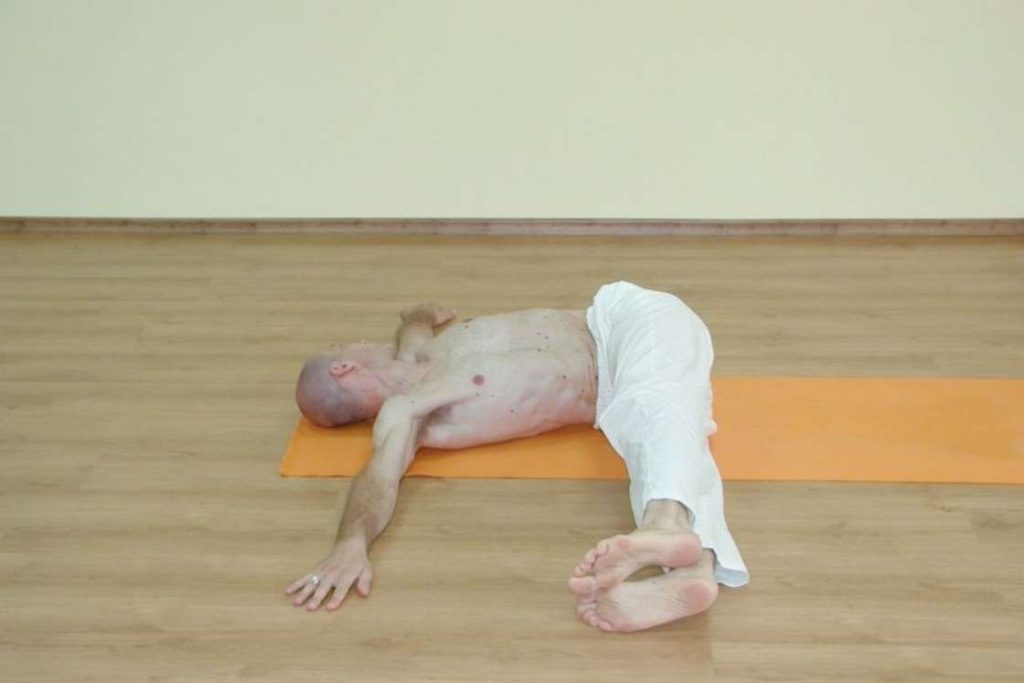
This variation is sometimes called the full Jathara Parivartanasana because here legs are extended fully on either side instead of bending at the knee.
It is attained by lying in a supine position and arms extended perpendicular to the body. It is followed by lifting the knees with feet on the floor. Raise the legs, then lower the stacked legs and hips towards the left on the floor. Turn the neck to the right to look in the opposite direction of the legs. You can also grab the outside of the right foot with the left hand. Repeat it to the other side.
2. Eka Pada Jathara Parivartanasana
As the name suggests, this abdominal twist is achieved by lowering only one leg to the alternate side on the floor.
For this, the practitioner bends one leg (say, left) at the knee in the supine position. The arms position remains the same T-shaped as in the original pose.
The left leg is lifted either bent or straight and lowered to the right side on the floor over the extended right leg. This is followed by twisting the neck muscles to the left.
3. Jathara Parivartanasana with Eagle legs
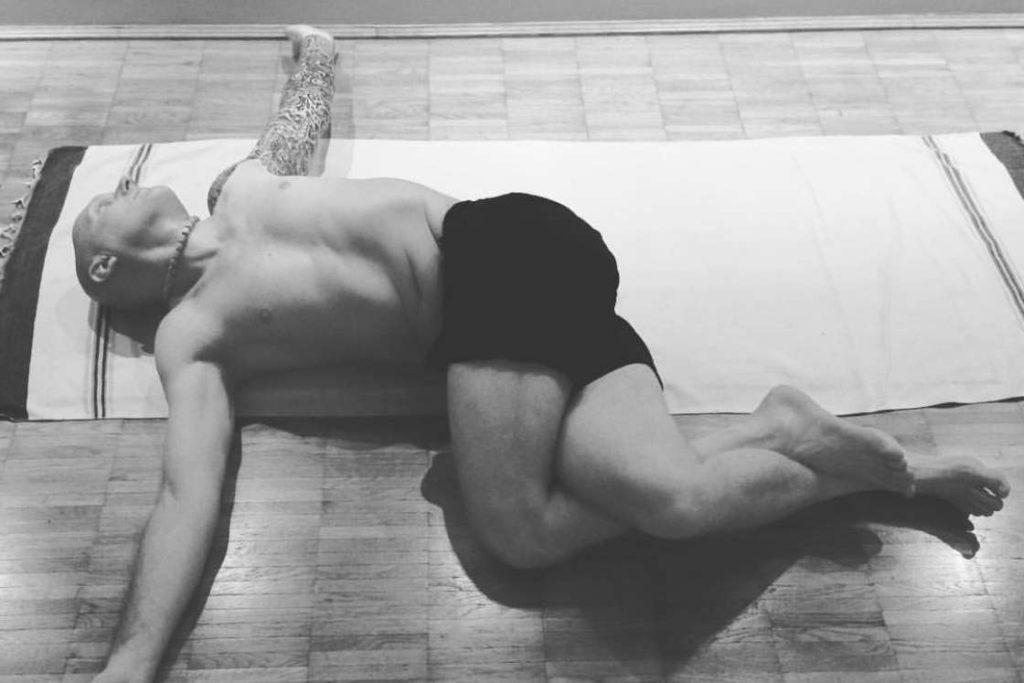
This pose only varies in the legs position from the base pose. After bending the knees place the feet on the floor, and wrap the left leg over the right thigh.
Now lower the wrapped eagle legs to the right side on the floor. Extend your left arm and look towards the left while the right-hand stays on the legs.
Therapeutic Use
- Jathara parivartanasana has relieving action on lower back pain.
- It alleviates and removes stiffness in the back, neck, and shoulders.
- This serves as a mind refresher by releasing the pent up emotions and cures stress and depression.
- This posture is beneficial in eliminating constipation and gas.
- Jathara parivartanasana strengthens the pelvic floor muscles and thus prevents the issues related to menstruation including chronic pelvic pain.
- Jathara parivartanasana is recommended to people with insomnia.
- It is a great posture for treating bladder related issues.
Jathara Parivartanasana Benefits
1. Stretches the spine – Jathara parivartanasana performed lying on the back and massages the back muscles. It stretches the spinal muscles from the bottom to the crown of the head and improves spinal flexibility.
2. Strengthens the legs – This pose stretches the buttocks, hamstrings, calves muscles. It improves the flexibility and mobility of the legs thus strengthens these muscles.
3. Tones the abdomen – Jathara parivartanasana squeezes the core muscles and oblique muscles are also stretched. It leaves massaging effects on the liver, pancreas, stomach, kidney, etc. Hence tones the abdomen internally and externally.
4. Aids digestion – Due to the stimulation of abdominal organs, it facilitates the functioning of digestive organs. It helps in secreting digestive juices and helps in the elimination process, thus aids in better digestion.
5. Relieves fatigue – This posture is beneficial in getting rejuvenated after a tiring and stressful day at work. It releases muscular tension and toxins from the body. Thus energizes and revitalizes the body.
6. Stimulates Manipura Chakra – As the abdomen is twisted in this pose, the awareness is kept around the navel. It stimulates the solar plexus (Manipura chakra) promoting the digestive fire and regulates the body heat.
It also promotes the interpersonal growth of the practitioner by increasing the self-esteem and confidence levels.
Conclusion
Treat yourself with a sense of relaxation by indulging in Jathara parivartanasana to release the toxins out of the body.
Expose your abdominal muscles into this twisting posture to lead your day with energy, confidence, and refreshment.
